#Regulatory Structure
Explore tagged Tumblr posts
Text
Healthcare Landscape in Pakistan – Regulatory Structure – Asrar Qureshi’s Blog Post 981
#Asrar Qureshi#Blogpost981#DRAP#Healthcare#NIH#Pharma Veterans#PMDC#Private healthcare#Public healthcare#Regulatory Structure
0 notes
Text
zooms in on myself in my job, two years down the line. isn't it spooky i can have whole technical conversations now and make strategic decisions because i actually understand the work now?
#realizations i make after my team meeting where im like whoa. im a fully blown useful knowledgeable person now#they arent really carrying me anymore! im just doing it and saying stuff and being confident about it!#also yeah it takes like 2 years to understand this job LOL#the entire structure and the way the org works and the complex regulatory dynamics between fed/state/tribe/city#it's not something you grasp from the outside in. but if i were to switch to another job it would be simpler now#but starting as a brand new fresh out of college employee it takes TIME to even figure out where the limits of our oversight is
16 notes
·
View notes
Text
The Value of a Residential Estimating Service in 3D Printed Home Construction
The rise of 3D printed homes is revolutionizing the construction industry. By using additive manufacturing technology, builders can create homes with greater precision, less waste, and reduced labor costs. However, while the technology promises cost savings, the unique nature of 3D printed homes requires specialized budgeting and planning to ensure projects are financially viable. A residential estimating service plays a crucial role in this process by helping to forecast accurate costs, accounting for the intricacies and potential challenges that arise in 3D printed home construction.
As 3D printing technology continues to evolve, homeowners and developers need reliable estimating services to navigate the complexities of this innovative construction method. These services help ensure that projects stay within budget while meeting quality standards and project timelines.
Understanding 3D Printed Home Construction
3D printing in home construction involves the use of a printer to create walls, floors, and other structural components layer by layer. The primary materials used in 3D printing for homes include concrete, clay, or composites, with printers capable of creating intricate designs that traditional methods cannot easily replicate.
While 3D printing offers numerous advantages—such as rapid construction, reduced labor, and customization options—its costs can vary significantly. Factors such as material choice, print size, project complexity, and technology specifications all impact the overall cost of a 3D printed home.
Budgeting for 3D Printing Materials
One of the primary considerations in estimating the cost of 3D printed homes is the material used. The quality, type, and quantity of the material play a major role in determining the total cost of the build. Concrete, often used in 3D printing due to its strength and durability, is typically more affordable than other materials, but the cost can still fluctuate depending on the supplier and local availability.
A residential estimating service helps clients understand the cost implications of using various 3D printing materials. The estimator will provide a detailed breakdown of material costs, considering factors such as material waste, transportation, and handling fees. Since the technology is still relatively new, these costs may not always be predictable, making an expert estimator’s role all the more vital in forecasting potential variances.
Labor and Printing Time Considerations
While 3D printing eliminates many manual construction tasks, such as bricklaying and framing, there are still labor costs associated with setup, monitoring the printing process, and post-printing tasks. The process of setting up the printer, maintaining equipment, and overseeing quality control requires skilled labor. The printing itself, although automated, is not instantaneous and can take days or even weeks depending on the complexity of the design.
A residential estimating service accounts for these labor costs and the printing time, which can be significantly different from traditional construction projects. The estimator can calculate labor costs for monitoring, troubleshooting, and finishing tasks, ensuring that these costs are incorporated into the budget. They also take into account any additional time required for material delivery, setup, and calibration.
Design Flexibility and Customization
One of the most attractive aspects of 3D printed homes is their design flexibility. With the ability to create complex, customized shapes and structures, 3D printing allows for architectural freedom that traditional construction methods often cannot achieve.
However, this flexibility can impact the budget. More intricate designs may require more material or longer printing times, leading to higher costs. A residential estimating service evaluates the design’s complexity and integrates these factors into the overall estimate. By balancing custom features with cost constraints, the estimator ensures that the project’s design vision aligns with the budget.
Site Preparation and Foundation Costs
Although 3D printing reduces the amount of manual labor required during construction, site preparation remains a crucial part of the process. Depending on the location, this could involve clearing the land, leveling the site, and ensuring the foundation is properly prepared to support the printed structure.
For a 3D printed home, the foundation typically consists of a reinforced concrete slab, which must be poured and cured before printing can begin. The residential estimating service accounts for these additional costs and provides a clear picture of what needs to be done to prepare the site. This includes evaluating soil conditions, assessing the need for grading, and determining the cost of the foundation installation.
Regulatory and Permit Costs
Like traditional construction, 3D printed homes must comply with local building codes and regulations. In some areas, building codes may not yet address 3D printed structures, making it necessary to consult with local authorities and engineers to ensure that the construction meets safety and code standards.
The residential estimating service plays a key role in navigating these regulatory challenges. The estimator helps identify the necessary permits, certifications, and inspections required for a 3D printed home, and factors these into the overall project budget. This helps avoid costly delays caused by missing permits or non-compliance with regulations.
Maintenance and Long-Term Durability
While 3D printed homes offer a unique and innovative building solution, homeowners and builders must also consider the long-term durability and maintenance of the materials used. 3D printed homes are generally built to last, but depending on the material used, they may require specific maintenance or repairs over time.
A residential estimating service can factor in the cost of maintaining the home in the future. For example, if the home is constructed with concrete or composite materials, the estimator will consider the potential for cracking, erosion, or other wear-and-tear issues. This long-term perspective helps homeowners budget for future repairs or upgrades that may be needed after construction.
Conclusion
The rise of 3D printed homes presents both exciting opportunities and unique challenges. While the technology promises cost savings and design freedom, accurately budgeting for a 3D printed home requires a detailed understanding of the materials, labor, site preparation, and regulatory considerations involved. A residential estimating service offers valuable expertise in these areas, helping homeowners and developers navigate the complexities of 3D printed home construction while staying on budget.
By providing a clear, comprehensive estimate, residential estimators ensure that all aspects of the project—from the initial design to the final finishing touches—are accounted for. With their help, homeowners can confidently embrace this innovative construction method while avoiding unexpected costs or delays.
#residential estimating service#3D printed homes#additive manufacturing#3D printing materials#construction budgeting#customized home design#concrete printing costs#labor for 3D printing#site preparation for 3D homes#3D printing labor#home foundation costs#regulatory compliance#building code for 3D printed homes#printing time budgeting#home design flexibility#customized home construction#printing equipment setup#3D printed structure#material waste costs#home permit fees#architectural freedom#future home maintenance#3D home durability#building with composites#3D printing in construction#site grading costs#local construction regulations#3D printed home foundation#labor for finishing#project timeline costs
0 notes
Text
#law#policy#legislation#General Corporate Advisory Mumbai#Corporate Legal Advisory Mumbai#Business Compliance Services Mumbai#Regulatory Structuring Advisory#Corporate Compliance Audit Mumbai
0 notes
Text
Legal Environment of Business

Unlock the door to business success by understanding the dynamic landscape of the legal environment. From the foundational pillars of business formation to the intricate web of contracts and intellectual property rights, every aspect demands attention in this intricate ecosystem. Navigate confidently through the maze of regulations, safeguard your interests, and mitigate risks effectively. Whether you're a sole proprietor charting your own course, a partnership sharing the load, or a corporation enjoying the benefits of limited liability, grasp the nuances to thrive in the global marketplace. It's not just about compliance; it's about leveraging the legal framework to propel your business towards excellence. Welcome to the forefront of business legality – where strategic understanding meets unparalleled opportunity. Read Full article.
0 notes
Text
Comprehensive Engineering Solutions with Little P.Eng.: Catalyzing Innovation Across Engineering
Engineering challenges in contemporary industry demand sophisticated, multidisciplinary approaches. Little P.Eng., a rising name in the engineering sector, has positioned itself as a nexus for solutions spanning various specialized fields, including structural engineering, piping design, piping stress analysis, seismic bracing design, storage tank design, material handling engineering services, pressure vessel design, electrical design, and CRN registration services. This article delves into each of these areas, highlighting the complexities, methodologies, and cutting-edge strategies employed by Little P.Eng. to cater to the evolving needs of diverse sectors.
Engineering services are the cornerstone of modern industrial and infrastructural developments. From the conceptualization of a project to its final commissioning, various engineering disciplines come into play to ensure functionality, safety, compliance, and efficiency. Little P.Eng., with its array of engineering services, has etched its mark by offering comprehensive solutions under one roof. The company's commitment to technical excellence, precision, and continual innovation positions it at the forefront of engineering consultancy.
Structural Engineering: Structural engineering, a critical subset of civil engineering, involves the analysis, design, and planning of structural components and systems to achieve design goals and ensure the safety and comfort of users or occupants. The experts at Little P.Eng. undertake detailed analyses, considering factors such as geology of the site, environmental conditions, and materials to be used, ensuring structural soundness against static and dynamic loading, including human traffic and environmental stressors.
The service spectrum includes:
Building Design: Erection of residential, commercial, and industrial structures with considerations for material efficiency, safety regulations, and aesthetic aspects.
Structural Analysis and Inspection: Employing advanced tools to analyze stress, strain, and load distribution and conducting inspections to assure structural integrity and longevity.
Foundation Design: Creating robust foundations, including piles, rafts, and footings, customized to site conditions and building requirements.
Retrofitting and Rehabilitation: Strengthening existing structures through modernization techniques, enhancing our capacity to withstand additional or unanticipated loads.
Piping Design and Piping Stress Analysis: Piping systems are lifelines of process industries, influencing operational efficiency, safety, and economic feasibility. Little P.Eng. offers comprehensive solutions in piping design, ensuring optimal layout and functionality, accommodating project constraints, and adhering to international standards.
Key aspects include:
Piping Layout and 3D Modeling: Developing detailed piping system layouts, incorporating equipment placement, structural design, and safety compliance, facilitated through advanced 3D modeling for accuracy and visualization.
Stress Analysis: Utilizing software tools like CAESAR II for precise stress analysis, determining strain and stress levels within piping systems under various scenarios, including temperature changes, fluid dynamics, pressure variations, and external forces, thereby verifying system reliability and identifying necessary supports and reinforcements.
Seismic Bracing Design: In regions prone to seismic activity, designing structures with adequate bracing is crucial to prevent collapse and minimize damage during earthquakes. Little P.Eng.'s seismic bracing designs are tailored to enhance the resilience of structures, factoring in regional seismic activity, local regulations, and material specifications.
Services involve:
Seismic Risk Evaluations: Assessing seismic risks associated with specific locations, analyzing historical data, and geological conditions.
Bracing System Design: Engineering customized bracing systems, including base isolators, cross-bracing, and shear walls, to dissipate seismic forces and minimize structural vulnerability.
Post-Earthquake Assessments: Inspecting and evaluating structures post-seismic activity for damage assessment and further reinforcement recommendations.
Storage Tank Design: Storage tanks, essential for industries requiring liquid or gas storage, entail specialized design parameters. Little P.Eng. focuses on custom solutions, factoring in the stored substance's characteristics, environmental considerations, and industry regulations.
The design process encompasses:
Material Selection and Design: Choosing appropriate materials resistant to the stored contents and environmental conditions, and designing tanks based on capacity requirements, pressure ratings, and structural regulations.
Foundation and Settlement Analysis: Ensuring ground stability and accommodating potential settlement or shifts without compromising tank integrity.
Safety and Emission Controls: Integrating features to prevent leaks, limit emissions, and safeguard against potential hazards, including explosions or toxic releases.
Material Handling Engineering Services: Efficient material handling is pivotal to operational success in manufacturing, warehousing, and distribution facilities. Little P.Eng. offers engineering solutions optimizing the movement, storage, control, and protection of materials throughout the process.
These services include:
System Design and Integration: Developing comprehensive systems combining conveyors, automated storage and retrieval systems, and transfer equipment, ensuring seamless, efficient operations.
Equipment Selection and Procurement: Advising on the appropriate equipment tailored to specific operational needs and assisting with acquisition from reputable manufacturers.
Safety and Ergonomics: Designing systems prioritizing operator safety and ergonomics, reducing workplace hazards and potential for injury.
Pressure Vessel Design: Pressure vessels, used for holding gases or liquids at high pressures, require meticulous design to prevent failure and catastrophic results. Little P.Eng.'s expertise lies in crafting pressure vessels compliant with industry standards like the ASME Boiler and Pressure Vessel Code.
Specific services involve:
Design and Analysis: Performing detailed calculations for wall thickness, stress distribution, and overall vessel geometry, ensuring safety under various pressure conditions.
Material Specification and Fabrication Oversight: Specifying suitable materials able to withstand extreme pressures and overseeing the fabrication process for quality assurance.
Inspection and Certification: Conducting thorough inspections and facilitating necessary certifications, confirming adherence to safety and operational standards.
Electrical Design: Electrical design services encompass the planning and execution of electrical systems, vital for the operational integrity of residential, commercial, and industrial projects. Little P.Eng.'s electrical engineers are adept at crafting systems that meet energy efficiency, safety, and performance standards.
Critical offerings include:
System Layout and Design: Creating comprehensive electrical systems, including power distribution, lighting, and emergency backup systems, tailored to specific project requirements.
Compliance and Safety: Ensuring designs meet electrical codes and safety standards, incorporating protective measures to prevent system failures, electrical shocks, or fire hazards.
Energy Efficiency Solutions: Proposing energy-efficient technologies and methodologies, contributing to sustainable and cost-effective operations.
CRN Registration Services: The Canadian Registration Number (CRN) is a number issued by each province or territory of Canada for the design of a boiler, pressure vessel, or fitting. The CRN identifies that the design has been accepted and registered for use in that province or territory. Little P.Eng. assists with the complex process of obtaining CRN certifications, essential for legal and safe operation within Canada.
This process includes:
Design Evaluations: Reviewing pressure equipment designs to ensure they comply with pertinent regulations and standards.
Documentation Preparation: Compiling and preparing extensive documentation required for CRN applications, including drawings, calculations, and material test reports.
Liaison with Authorities: Acting as an intermediary between clients and regulatory bodies, facilitating communication and expediting the registration process.
Conclusion: Little P.Eng. has emerged as a one-stop solution for diverse engineering needs, driven by a team of experts dedicated to upholding the highest standards of engineering excellence. Our approach is not just about meeting the minimum regulatory requirements; it is about designing safe, efficient, and sustainable systems that stand the test of time. By embracing advanced technologies, up-to-date methodologies, and a customer-centric approach, Little P.Eng. is setting new benchmarks in the engineering domain, contributing significantly to industrial innovation and infrastructural advancement.
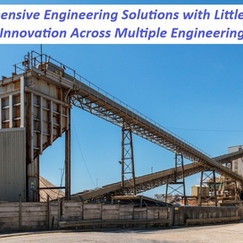

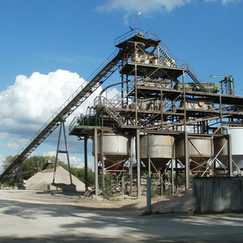


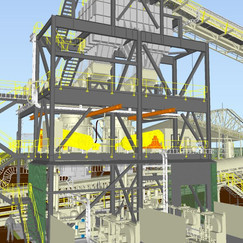
Tags:
CAESAR II
energy efficiency
structural engineering
material handling
3D modeling
safety standards
regulatory compliance
earthquake resilience
stress analysis
CRN registration
advanced technologies
engineering consultancy
fabrication oversight
rehabilitation
piping design
pressure vessel
project commissioning
retrofitting
electrical design
automated storage
operational excellence
system reliability
ASME compliance
seismic bracing
foundation design
storage tank
tank integrity
design evaluation
infrastructural advancement
industrial innovation
Engineering Services
Structural Engineering Consultancy
Pipe Stress Analysis Services
Located in Calgary, Alberta; Vancouver, BC; Toronto, Ontario; Edmonton, Alberta; Houston Texas; Torrance, California; El Segundo, CA; Manhattan Beach, CA; Concord, CA; We offer our engineering consultancy services across Canada and United States. Meena Rezkallah.
#CAESAR II#energy efficiency#structural engineering#material handling#3D modeling#safety standards#regulatory compliance#earthquake resilience#stress analysis#CRN registration#advanced technologies#engineering consultancy#fabrication oversight#rehabilitation#piping design#pressure vessel#project commissioning#retrofitting#electrical design#automated storage#operational excellence#system reliability#ASME compliance#seismic bracing#foundation design#storage tank#tank integrity#design evaluation#infrastructural advancement#industrial innovation
0 notes
Text
Self-Healing Materials Market is Led by the Polymers Category
The self-healing materials market is experiencing significant growth and it will continue this trend in the years to come.
The growth of the industry is primarily attributed to the continuous inventions in the advanced material field intended for self-healing; surging acceptance of these materials in the healthcare, electronics, and automotive sectors; and their greater long-term financial advantages over conventional materials.

Self-healing materials assist in boosting the lifespan of systems, as they restore the damages and further lessen the growing entropy. The most substantial utilizations of such materials are in the aerospace, automotive, oil & gas, and building & construction sectors. The utilizations in the automotive sector comprise self-healing elastomers-based anti-scratch polyurethane coatings for vehicle bodies.
Moreover, the major application in the construction sector is self-healing asphalt. Capsules comprising oil are embedded in the bituminous binder to boost the asphalt roof covering lifespan. Therefore, the expansion in these sectors is resulting in the advancement of the industry.
Various innovations in self-healing materials have been observed, in the past few years, in the domain of advanced material. This advancement in technology has resulted in quicker healing and boosted the repair of the performance of these materials. This would cause a new era of environmental management and infrastructure preservation technologies. Therefore, research & development in cutting-edge materials has become a key trend in the industry.
In the past few years, the polymers category, based on material, accounted for the largest self-healing materials market share, and it will further advance at a considerable rate in the years to come. This is mainly because polymers imitate biological healing and heal themselves without requiring any external interference when they endure damage.
In the past few years, the building & construction category, based on application, accounted for the largest share of the self-healing materials industry. This is mainly because of the surging utilization of such materials in non-residential construction. These materials can restore early-stage damage, which, if unchecked, might result in material failure.
The European self-healing materials industry accounted for the largest share in the past few years, and it is likely to further advance at a substantial rate in the years to come.
#Self-Healing Materials market#materials science#market trends#global market outlook#innovative technologies#market dynamics#research and development#structural applications#market growth factors#construction materials#regulatory landscape#quality assurance#automotive coatings#biomimicry
1 note
·
View note
Text
Conversion of Company
Section 18 of the Companies Act of 2013 allows a registered company to change its type by amending the Memorandum of Association (MOA) and Articles of Association (AOA).
🌐 Navigate the evolution of your company! Learn the ins and outs of transitioning from a One-Person Company to a dynamic Private Limited or Public Company. 💡
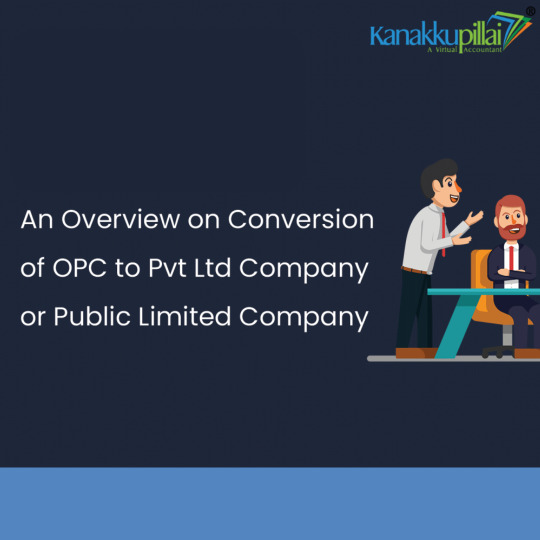
For new business registration and support, contact kanakkupillai today. 🌌🚀
Swipe To Learn More >>>

For more information, please write to us at [email protected] or visit https://www.kanakkupillai.com/learn/conversion-of-company/
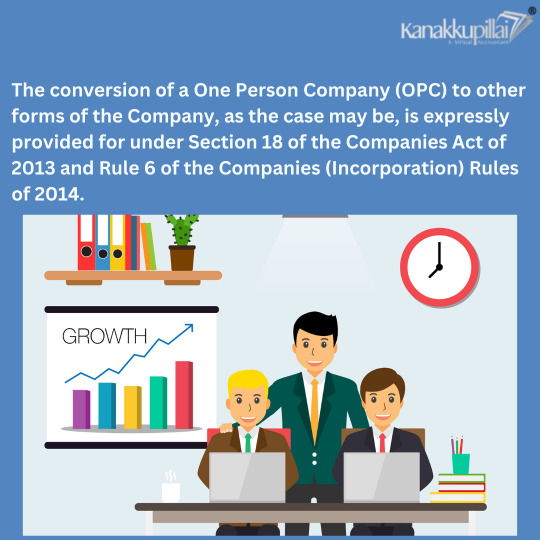
How can a business undergo conversion?
By amending the Memorandum of Association and Articles of Association, a company can transform into another type following the regulations of the Companies Act 2013. Subsequently, apply to the Registrar of Companies (ROC) and close the previous registration upon approval.
After completing all necessary paperwork, the company will receive a certificate of incorporation. Here, the Registrar will give the business a new certificate of incorporation, which states its converted or new form.
Additionally, note that such conversion will not impact liabilities, debts, or other obligations incurred before the conversion. The company retains its debts, liabilities, obligations, contracts, etc., even after adopting a new legal structure consistent with the 2013 Companies Act. This lawful provision pertains to company conversions, reflecting the contemporary trend of rapid expansion and evolving company statuses. To accommodate the requirements and overcome the limitations of existing ones. Therefore, we will learn about the various conversion options currently available or possible under Indian taxation and government regulations.
Partnership Firm to LLP Conversion
Since introducing the LLP Act in 2008, many partnership firms have chosen to convert their structure to Limited Liability Partnerships (LLPs).
The advantages of conversion are evident and understandable, encompassing the ability to welcome unlimited partners, establish various legal entities, enjoy limited liability, and facilitate swift ownership transfer through a simplified form. Owing to these advantages, Limited Liability Partnerships (LLPs) have gained popularity among small and medium-sized firms in a growing economy like India.
Retaining all partners from the original firm is crucial when converting a Partnership Firm to an LLP. Kanakkupillai recommends retiring non-consenting partners and adding new ones after LLP incorporation.
Explore Further: Conversion from Partnership Firm to LLP
Given its minimal compliance and documentation requirements, small and medium-sized entities, as well as Indian entrepreneurs, widely favour Sole Proprietorship. As the business and incomes expand, entrepreneurs need to comply with the sole requirement of opening a trade with current accounts and furnishing the PAN details of the proprietor for income tax filings.
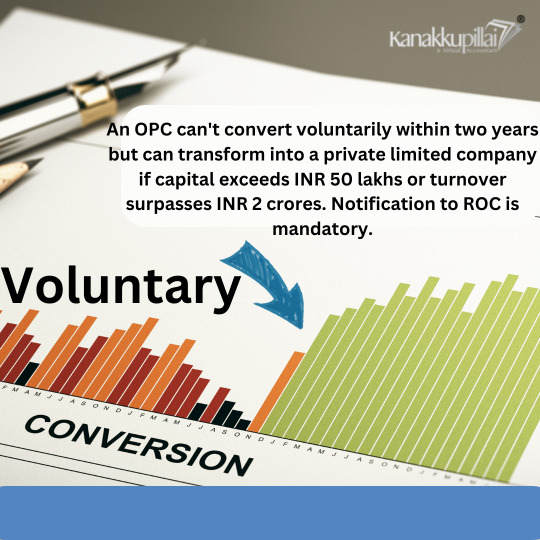
As the business thrives and another peak awaits, entrepreneurs can transition their Sole Proprietorship into a Private Limited Company. It involves drafting an agreement between the Proprietorship and the newly incorporated Private Limited Company to sell the firm. The transformation process is complete when the newly formed Private Limited Company assumes control of the Sole Proprietorship Concern, as outlined in its Memorandum of Association.
Step-by-Step Procedure for Conversion of Company:
1. Evaluate Eligibility: Confirm if the company is eligible for conversion based on legal criteria.
2. Board Resolution: Pass a board resolution approving the conversion and convene a meeting.
3. Member Approval: Seek approval from shareholders through a special resolution in a general meeting.
4. Application Filing: Apply conversion with the appropriate regulatory authority.
5. Registrar Approval: Seek approval from the Registrar of Companies (RoC) for the conversion.
6. Drafting New Documents: Prepare new Memorandum and Articles of Association compliant with the converted structure.
7. Issue New Shares: If required, issue new shares to the shareholders per the conversion terms.
8. Approval from Other Authorities: Obtain necessary approvals from other regulatory bodies if applicable.
9.NO Objection Certificates (NOCs): Obtain NOCs from existing creditors and authorities.
10. Publication of Notice: Publish a notice about the conversion in newspapers as mandated.
11. Issuance of Certificate: Once you meet all requirements, you will receive a fresh certificate of incorporation.
12. Update Pan and Tan: PAN and TAN details with the tax authorities.
13. Update Other Registrations: If applicable, update other registrations like GST.
14. Transfer of Assets and Liabilities: Transfer assets and liabilities under the conversion terms.
15. Compliance with Post-Conversion Requirements: Ensure ongoing compliance with regulations applicable to the new entity.
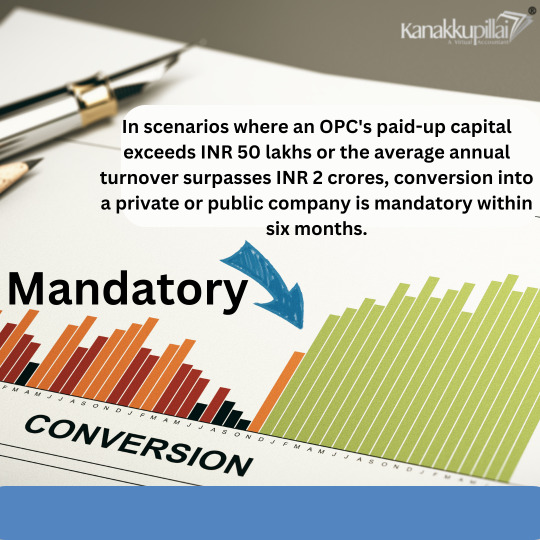
Documents Required for Conversion:
Memorandum and Articles of Association (updated)
Board and Shareholders Resolutions
Application for Conversion
NOCs from Creditors
Copy of Newspaper Publication
Updated PAN and TAN
Updated GST Registration (if applicable)
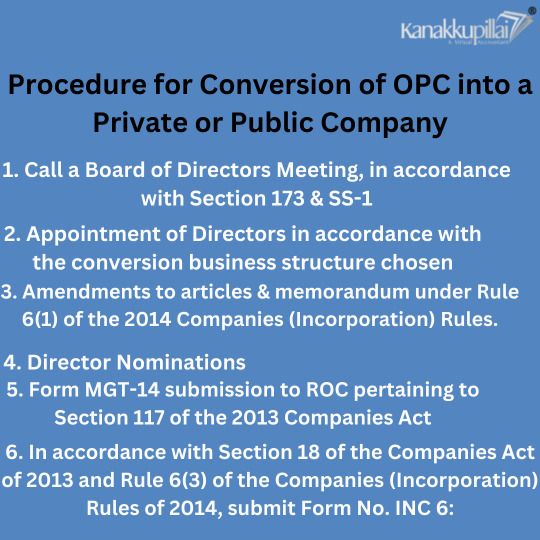
Benefits of Company Conversion:
1. Structural Flexibility: Choose a structure that aligns better with business goals.
2. Enhanced Credibility: Conversion to a higher structure may enhance business credibility.
3. Tax Benefits: Potential tax benefits based on the new structure.
4. Greater Access to Capital: Improved ability to raise capital based on the new structure.
5. Operational Efficiency: Streamlined operations based on the selected structure.

Why Choose Kanakkupillai for Company Conversion
Today, transform your business with Kanakkupillai's effortless and trouble-free company conversion services. Our team of experts will guide you through the entire process, ensuring a seamless transition from start to finish. Don't let complicated paperwork and legal requirements hinder your progress. Call us today at +91 7305 345 345 to get started!
Latest 15 Questions and Answers:
1. Why should I consider converting my company?
Conversion provides flexibility, tax benefits, and potential for enhanced business operations.
2. How long does the conversion process take?
Timelines vary, but it generally takes a few weeks to a few months.
3. What are the essential eligibility criteria for conversion?
Criteria include compliance with legal requirements and approval from shareholders.
4. Can any company be converted?
Eligibility depends on the existing and desired structures; not all conversions are possible.
5. What documents are needed for conversion?
Key documents include updated Memorandum, Articles of Association, resolutions, and NOCs.
6. Are there tax implications of conversion?
Yes, there can be tax implications, and it is advisable to seek professional advice.
7. How does conversion impact existing contracts?
Contracts generally continue, but reviewing and informing parties about the conversion is essential.
8. Can foreign companies be converted in the same way?
It is advisable to seek legal counsel, as conversion rules for foreign companies may vary.
9. What is the role of the Registrar of Companies (RoC) in the process?
RoC approves the conversion and issues a new certificate of incorporation.
10. Is shareholder approval necessary for conversion?
Yes, shareholder approval through a special resolution is typically required.
11. How are assets and liabilities transferred during conversion?
The terms outlined in the conversion plan govern the transfer.
12. Are there ongoing compliance requirements post-conversion?
Yes, ongoing compliance with the regulations applicable to the new structure is necessary.
13. Can a company convert to a different business type?
Yes, conversion allows changing the business type based on legal provisions.
14. What role do NOCs play in the conversion process?
NOCs from creditors and authorities affirm their consent for the conversion.
15. How does conversion impact existing employees?
Employment contracts generally continue, but HR policies may need adjustments.
Note: The information provided is general and may vary based on specific legal requirements and jurisdictions.
Related Keywords:
#CompanyConversion #BusinessTransformation #CorporateEvolution #StructuralFlexibility #LegalTransition #BusinessGrowth #StrategicConversion #CompanyRenewal #OperationalUpgrade #LegalCompliance #ShareholderApproval #CorporateAdaptation #RegulatoryTransition #BusinessFlexibility #CorporateMetamorphosis
#Company Conversion#Business Transformation#Corporate Evolution#Structural Flexibility#Legal Transition#Business Growth#Strategic Conversion#Company Renewal#Operational Upgrade#Legal Compliance#Shareholder Approval#Corporate Adaptation#Regulatory Transition#Business Flexibility#Corporate Metamorphosis
0 notes
Text
Ultra-Low Carbon Concrete: Paving the Way to Sustainable Construction
Introduction In the face of mounting environmental concerns, the construction industry is embracing innovative solutions to reduce its carbon footprint and promote sustainable practices. Among these solutions, the concept of ultra-low carbon concrete has gained significant traction. This cutting-edge material not only addresses the environmental challenges posed by conventional concrete…

View On WordPress
#Alternative Cementitious Materials#Carbon Capture and Utilization#Carbon Footprint Reduction#Competitive Advantage#Cost Savings#Enhanced Mix Design#Environmental Preservation#Green Construction Solutions#Regulatory Compliance#Research and Innovation#resource efficiency#Structural Performance#Sustainable Construction#Sustainable Future#Ultra-Low Carbon Concrete
0 notes
Text
Ultrasonic Thickness Measurement Services for Ships: Ensuring Ship Hull Integrity and Safety
Introduction:
The maritime industry heavily relies on the structural integrity of ships and vessels to ensure safe and efficient operations. Regular inspection and maintenance are essential to prevent potential accidents, maintain vessel reliability, and comply with regulatory standards. Ultrasonic thickness measurement services play a crucial role in ship maintenance and safety, enabling accurate assessment of ship hull integrity and identification of potential corrosion or structural issues. In this article, we will explore the significance of ultrasonic thickness measurement services for ships, along with various related aspects such as ship hull integrity assessment, close-up surveys, non-destructive testing, corrosion detection, and vessel structural integrity evaluation.

Ship Hull Integrity Assessment:
Ship hull integrity assessment is a fundamental aspect of ensuring the safety and seaworthiness of vessels. Ultrasonic thickness measurement services for ships provide a non-intrusive and reliable method to evaluate the thickness of the ship's hull plates, identifying any areas that may have experienced corrosion, erosion, or structural degradation over time. By assessing the hull integrity, potential risks can be mitigated, and appropriate maintenance measures can be implemented.
Close-up Surveys and Non-Destructive Testing in Vessel:
Close-up surveys involve a detailed examination of the ship's structure, focusing on specific areas prone to damage or stress. Ultrasonic thickness measurement is a valuable non-destructive testing technique used during close-up surveys. Highly trained technicians utilize specialized ultrasonic equipment to measure the thickness of the hull plates accurately. This method allows for the detection of hidden defects, such as corrosion pitting, without requiring invasive measures like cutting or drilling into the hull.
Ultrasonic Measurement of Hull Thickness:
Ultrasonic thickness measurement utilizes sound waves to determine the thickness of materials. In the context of ship maintenance, this technique involves sending ultrasonic waves through the hull plates and measuring the time it takes for the waves to return. By analyzing the wave reflections, technicians can determine the thickness of the hull plates with precision. This data helps evaluate the overall condition of the hull and identify areas that require immediate attention.
Ship Hull Corrosion Detection:
Corrosion is a significant concern for ship hulls due to constant exposure to harsh marine environments. Ultrasonic thickness measurement services excel at detecting corrosion and its extent within the hull structure. By regularly monitoring the thickness of the hull plates, technicians can identify areas where corrosion has thinned the material, posing a risk to the ship's structural integrity. Early detection of corrosion allows for timely repairs and prevents potentially catastrophic failures.
Vessel Structural Integrity Evaluation:
Ensuring the structural integrity of vessels is crucial for the safety of the crew, cargo, and the marine environment. Ultrasonic thickness measurement services provide vital data to evaluate the overall structural condition of a ship. By mapping the thickness measurements across the entire hull, technicians can identify potential weak spots, stress concentrations, or areas affected by fatigue. This evaluation aids in determining the vessel's remaining service life, and making informed decisions about maintenance, repairs, or structural modifications.
Marine Hull Condition Assessment:
Regular marine hull condition assessments are essential for maintaining vessel safety and regulatory compliance. Ultrasonic thickness measurement services offer a comprehensive means of assessing the condition of a ship's hull. By capturing accurate thickness data, technicians can monitor changes over time, identify deterioration trends, and plan maintenance strategies accordingly. This proactive approach helps prevent unforeseen incidents and ensures the vessel's long-term operability.
Ship Hull Thickness Monitoring and Vessel Integrity Assessment:
Continual monitoring of ship hull thickness is critical to identify thickness reduction or localized corrosion. Ultrasonic thickness measurement services enable ongoing monitoring of hull thickness, allowing for timely intervention and preventing unexpected structural failures. Such monitoring contributes to the overall vessel integrity assessment, ensuring that ships remain in compliance with safety standards and maritime regulations.
Hull Thickness Gauging Technology and Ship Maintenance:
The advancement of hull thickness gauging technology has significantly enhanced ship maintenance practices. Modern ultrasonic thickness measurement devices offer increased accuracy, portability, and ease of use. These advancements enable efficient and streamlined ship maintenance processes, reducing downtime and associated costs. By incorporating ultrasonic measurement techniques into regular maintenance routines, ship operators can prioritize safety, extend vessel lifespan, and optimize operational efficiency.
Conclusion:
Ultrasonic thickness measurement services for ships play a vital role in ensuring ship hull integrity, safety, and compliance with regulatory standards. By employing advanced non-destructive testing techniques, such as ultrasonic measurement, ship operators can detect corrosion, assess hull integrity, and evaluate vessel structural conditions accurately. Embracing these services as part of a comprehensive ship maintenance and safety strategy allows for proactive maintenance, preventing potential accidents and ensuring the continued reliability of maritime operations.
#ABS Approved UT Gauging Company#ABS Class Approved Service Suppliers UAE#Corrosion Prevention in Maritime Applications#Regulatory Compliance for Vessel Hulls#Early Detection of Hull Deterioration#Structural Integrity of Vessels#engineeringservices#marine service#maintainance#repair services#business
0 notes
Text
Corporate Management in Larger Organizations – Issues - Asrar Qureshi’s Blog Post #940

View On WordPress
#Asrar Qureshi#Blogpost940#Corporates#Corruption#Governance#Inefficiency#Management#Office Politics#Pharma Veterans#Regulatory Structure#Silos
0 notes
Text
The Klamath River’s salmon population has declined due to myriad factors, but the biggest culprit is believed to be a series of dams built along the river from 1918 to 1962, cutting off fish migration routes.
Now, after decades of Indigenous advocacy, four of the structures are being demolished as part of the largest dam removal project in United States history. In November, crews finished removing the first of the four dams as part of a push to restore 644 kilometres (400 miles) of fish habitat.
“Dam removal is the largest single step that we can take to restore the Klamath River ecosystem,” [Barry McCovey, a member of the Yurok Tribe and director of tribal fisheries,] told Al Jazeera. “We’re going to see benefits to the ecosystem and then, in turn, to the fishery for decades and decades to come.” ...
A ‘watershed moment’
Four years later, [after a catastrophic fish die-off in 2002,] in 2006, the licence for the hydroelectric dams expired. That created an opportunity, according to Mark Bransom, CEO of the Klamath River Renewal Corporation (KRRC), a nonprofit founded to oversee the dam removals.
Standards for protecting fisheries had increased since the initial license was issued, and the utility company responsible for the dams faced a choice. It could either upgrade the dams at an economic loss or enter into a settlement agreement that would allow it to operate the dams until they could be demolished.
“A big driver was the economics — knowing that they would have to modify these facilities to bring them up to modern environmental standards,” Bransom explained. “And the economics just didn’t pencil out.”
The utility company chose the settlement. In 2016, the KRRC was created to work with the state governments of California and Oregon to demolish the dams.
Final approval for the deal came in 2022, in what Bransom remembers as a “watershed moment”.
Regulators at the Federal Energy Regulatory Commission (FERC) voted unanimously to tear down the dams, citing the benefit to the environment as well as to Indigenous tribes...
Tears of joy
Destruction of the first dam — the smallest, known as Copco 2 — began in June, with heavy machinery like excavators tearing down its concrete walls.
[Amy Cordalis, a Yurok Tribe member, fisherwoman and lawyer for the tribe,] was present for the start of the destruction. Bransom had invited her and fellow KRRC board members to visit the bend in the Klamath River where Copco 2 was being removed. She remembers taking his hand as they walked along a gravel ridge towards the water, a vein of blue nestled amid rolling hills.
“And then, there it was,” Cordalis said. “Or there it wasn’t. The dam was gone.”
For the first time in a century, water flowed freely through that area of the river. Cordalis felt like she was seeing her homelands restored.
Tears of joy began to roll down her cheeks. “I just cried so hard because it was so beautiful.”
The experience was also “profound” for Bransom. “It really was literally a jolt of energy that flowed through us,” he said, calling the visit “perhaps one of the most touching, most moving moments in my entire life”.
Demolition on Copco 2 was completed in November, with work starting on the other three dams. The entire project is scheduled to wrap in late 2024.
[A resilient river]
But experts like McCovey say major hurdles remain to restoring the river’s historic salmon population.
Climate change is warming the water. Wildfires and flash floods are contaminating the river with debris. And tiny particles from rubber vehicle tires are washing off roadways and into waterways, where their chemicals can kill fish within hours.
McCovey, however, is optimistic that the dam demolitions will help the river become more resilient.
“Dam removal is one of the best things we can do to help the Klamath basin be ready to handle climate change,” McCovey explained. He added that the river’s uninterrupted flow will also help flush out sediment and improve water quality.
The removal project is not the solution to all the river’s woes, but McCovey believes it’s a start — a step towards rebuilding the reciprocal relationship between the waterway and the Indigenous people who rely on it.
“We do a little bit of work, and then we start to see more salmon, and then maybe we get to eat more salmon, and that starts to help our people heal a little bit,” McCovey said. “And once we start healing, then we’re in a place where we can start to help the ecosystem a little bit more.”"
-via Al Jazeera, December 4, 2023
#indigenous#river#riverine#ecosystem#ecosystem restoration#klamath#klamath river#oregon#california#yurok#fishing#fisheries#nature is healing#literally this time lol#united states#dam removal#climate change#conservation#sustainability#salmon#salmon run#water quality#good news#hope#rewilding#ecology#environment
5K notes
·
View notes
Text
CELİKELCPA - PLATİNUM

Are you considering taking the exciting plunge into the dynamic Turkish market? Look no further than Celik El CPA, your trusted partner for seamless company formation and registration in Turkey. As an expert in navigating the complexities of business setup, our services cater to both local and international entrepreneurs eager to establish a foothold in this vibrant economy. With our knowledgeable Turkey accountants by your side, you can rest assured that your financial matters will be managed with precision and care. From navigating regulatory requirements to ensuring compliance, we simplify the process of starting a business in Turkey.
Company Formation in Turkey
Setting up a business in Turkey can be an excellent decision for both local and foreign entrepreneurs. The process of company formation in Turkey is streamlined and relatively straightforward, making it a lucrative destination for investment. With the right guidance, including the assistance of professional Turkey accountants, you can navigate through legal requirements with ease.
One of the key aspects in securing a successful company registration in Turkey is understanding the various business structures available, such as limited liability companies (LLCs) and joint-stock companies. Each type has its unique benefits and requirements, which is why consulting with experts is advisable to choose the best option for your business model.
Moreover, Turkey's strategic location and growing economy provide a wealth of opportunities for business growth. Whether you're considering import-export businesses or tech startups, the benefits of entering the Turkish market are plentiful. You can leverage local resources and a young workforce, enhancing the potential for business success.
When you’re ready to start your business journey, ensure that you have all the necessary documents submitted accurately to avoid delays in the registration process. With the right support, how to start a business in Turkey can become a seamless experience!
Company Registration in Turkey
Company Registration in Turkey is a crucial step for entrepreneurs looking to establish a business presence in this vibrant market. The process involves several key steps that are designed to ensure compliance with local laws and regulations.
Step-by-Step Process
Choose Your Business Structure: Decide on the type of entity that best suits your business needs, such as a limited liability company (LLC) or joint-stock company.
Prepare Necessary Documentation: Gather all required documents, including your business plan, identity proof, and proof of address.
Open a Bank Account: Deposit the minimum required capital into a Turkish bank account and obtain a bank receipt.
Notary Public: Have your company’s articles of association drafted and notarized.
Register with the Trade Registry Office: Submit your documents to the local Trade Registry office to officially register your company.
Obtain Tax Registration: After registration, apply for a tax identification number from the Tax Office.
Benefits of Registering Your Company in Turkey
Completing the company registration process not only gives your business legal standing but also opens doors to various advantages such as:
Access to a growing market with a dynamic economy.
Eligibility for local and international contracts.
Enhanced credibility with clients and investors.
Engaging with experienced Turkey accountants such as those at Celikel CPA can significantly streamline your registration process. Their expert guidance ensures all steps are efficiently handled, allowing you to focus on your core business activities.
Ready to take the plunge and establish your presence in Turkey? Start your journey today with the support of dedicated professionals who are there to guide you through every step of How to Start a Business in Turkey.
Turkey Accountants
When planning for company formation in Turkey, selecting a skilled accountant is crucial to ensure compliance with local regulations. Experienced Turkey accountants possess in-depth knowledge of the Turkish tax system and can guide you through the intricacies of company registration in Turkey.
These professionals are adept at various services including bookkeeping, financial reporting, and tax planning, which are essential for new businesses. With their expertise, they help business owners navigate the complexities of local financial obligations, enabling you to focus on building your company.
If you are considering how to start a business in Turkey, partnering with the right accounting firm can significantly streamline your operations and enhance your chances of success. Ensure that your financial foundations are strong with professional help, positioning your business on the path to growth.
How to Start a Business in Turkey
How to starting a business in Turkey can be an exciting and rewarding venture. With its strategic location, dynamic market, and favorable investment climate, the country is an excellent choice for entrepreneurs. Here’s a concise guide to navigating the essential steps so you can move forward confidently.
Choose Your Business Structure: The first step is to decide on the type of business entity that suits your needs. Options include limited liability companies (LLCs), joint-stock companies (JSCs), and sole proprietorships. Each structure comes with its own regulatory requirements and tax implications, so it's essential to choose wisely.
These steps can set the foundation for your success in Turkey’s vibrant market landscape. With effective company registration in Turkey and the guidance of experienced Turkey accountants at your side, you will be well-equipped to launch and grow your business.
For more detailed assistance and tailored advice, don't hesitate to visit Celik & Co. CPA—your trusted partner in navigating the complexities of starting a business in Turkey.
1K notes
·
View notes
Text
An In-Depth Review of Piping Stress, Structural Engineering, and Seismic Bracing Design under OSHPD
Engineering in the healthcare sector stands at the crossroads of innovation and public safety, holding a critical role in societal well-being, especially in regions like California, governed by the stringent Office of Statewide Health Planning and Development (OSHPD) standards. This comprehensive examination delves into the expertise of Little P.Eng. Engineering in delivering specialized services in piping stress analysis, structural engineering, and seismic bracing design. These critical components demand a multifaceted approach to ensure healthcare facilities' robustness and resilience. This article elucidates the complex interplay of these engineering domains, emphasizing adherence to OSHPD regulations, and underscores the imperative of integrating these specialized services to create healthcare infrastructures that withstand time and unforeseen calamities.
1. The engineering intricacies involved in establishing resilient healthcare facilities are vast and complex, necessitating a specialized focus on several fronts. In the state of California, healthcare infrastructure must comply with OSHPD standards, ensuring these establishments are equipped to serve without falter, particularly in crisis scenarios. Little P.Eng. Engineering, offering dedicated services in piping stress analysis, structural engineering, and seismic bracing design, operates within this highly regulated space, providing solutions that meet both the operational demands and the rigorous safety standards set by regulatory bodies. This extensive analysis highlights the significance, challenges, and advanced strategies implemented in these engineering realms, particularly reflecting on their convergence in creating healthcare facilities that promise safety, efficiency, and longevity.
2. Piping Stress Analysis: Beyond Mere Compliance In the healthcare sector, the network of piping is its lifeline. These complex systems, transporting critical fluids, medical gases, and waste, require precise engineering to prevent system failures that could directly impact patient care and facility operations.
2.1 The Vital Role of Piping Systems in Healthcare Piping systems in healthcare facilities are complex, owing to the variety of mediums they transport. A minor lapse in maintaining the structural integrity of these systems can lead to significant operational disruptions, compromising patient safety and care.
2.2 Piping Stress Analysis: What It Entails This engineering service extends beyond basic calculations, requiring comprehensive analysis to anticipate potential stressors that could affect piping systems' stability, ranging from internal factors like fluid pressure and temperature fluctuations to external influences, including seismic activity.
2.3 Challenges in Healthcare Settings The healthcare environment poses unique challenges for piping stress analysis. Facilities operate around the clock, handling high-pressure gases, temperature-sensitive materials, and biohazardous wastes, necessitating a foolproof design to prevent catastrophic failures.
2.4 OSHPD Standards for Piping Systems Adherence to OSHPD regulations ensures that piping systems comply with safety and operational efficacy standards. These guidelines cover various aspects, from material selection and joint design to the comprehensive documentation of the analysis process, facilitating regulatory approval and ensuring system reliability.
3. Structural Engineering: The Foundation of Healthcare Resilience Healthcare facilities, by their very nature, require robust structures. The role of structural engineering is pivotal in ensuring these buildings are capable of supporting the demanding environment within, from heavy medical equipment to the constant influx of people.
3.1 Complexity in Healthcare Infrastructure The structural design of healthcare facilities is a complex undertaking. These buildings must support an array of functions, accommodate evolving medical technologies, and meet the stringent regulatory requirements imposed to ensure patient, staff, and visitor safety.
3.2 Structural Engineering Considerations Key considerations include understanding the dynamic loads, planning for future expansions, and ensuring the structure's flexibility to accommodate state-of-the-art medical equipment and technology. The design must also facilitate easy navigation, promoting efficiency in patient care and staff workflow.
3.3 Adherence to OSHPD Compliance OSHPD's compliance standards are comprehensive, dictating various structural components from earthquake resistance to fire safety. Structural engineering services must navigate these regulations adeptly, ensuring the facility's compliance without compromising on design efficiency and operational practicality.
4. Seismic Bracing Design: An Imperative in Earthquake-Prone Regions In regions susceptible to earthquakes, designing healthcare facilities requires an added layer of complexity – seismic bracing. This aspect of structural engineering is crucial in safeguarding the building’s integrity and functionality in the face of seismic events.
4.1 The Science Behind Seismic Bracing Seismic bracing involves reinforcing a building’s structure to withstand the forces exerted during an earthquake. This process requires detailed calculations and innovative design approaches to minimize structural damage and protect occupants’ lives during seismic activities.
4.2 Designing for the Unknown One of the primary challenges of seismic bracing design is the unpredictability of earthquakes. Engineers must consider various scenarios, employing dynamic analyses and modeling to predict the structure’s response to different seismic events and design appropriate reinforcements.
4.3 OSHPD’s Seismic Regulations In California, OSHPD regulations mandate that healthcare facilities be designed to sustain minimal damage and remain operational in the event of an earthquake. This entails rigorous seismic bracing design, ensuring that both the main structural elements and the non-structural components are reinforced to withstand seismic forces.
5. The Convergence of Disciplines: A Comprehensive Approach The creation of a resilient healthcare facility requires the seamless integration of various engineering disciplines. Little P.Eng. Engineering, with its specialized services, undertakes this comprehensive approach, ensuring each aspect is meticulously addressed and cohesively brought together for a robust final structure.
5.1 Integrated Engineering Excellence The interconnectedness of these disciplines means that a holistic approach is not just beneficial but necessary. For instance, the seismic bracing design directly impacts the piping systems and the overall structural integrity. A coordinated strategy ensures that enhancements in one area do not inadvertently create vulnerabilities in another.
5.2 Navigating Regulatory Compliance Compliance with OSHPD regulations often requires a balancing act, adhering to safety standards while striving for cost-effectiveness and operational efficiency. An integrated approach allows for a smoother navigation of these regulatory waters, streamlining the compliance process, and reducing the likelihood of costly or time-consuming revisions.
5.3 Case Studies: Demonstrating Competence and Innovation Real-world examples highlight how Little P.Eng. Engineering has successfully navigated complex projects, showcasing their expertise in these individual sectors and their skill in synergizing these services to create healthcare facilities that stand the test of time and unforeseen disasters.
6. Looking Ahead: The Future of Engineering in Healthcare As we forge into the future, the realms of piping stress analysis, structural engineering, and seismic bracing design will continue to evolve, shaped by advancements in technology, changes in regulatory landscapes, and lessons learned from past experiences.
6.1 Embracing Technological Advancements Future directions include the increasing incorporation of technology, such as Building Information Modeling (BIM) and Artificial Intelligence (AI), to enhance precision in design and analysis processes, thereby improving the efficiency, safety, and sustainability of healthcare structures.
6.2 Preparing for the Unpredictable The importance of future-proofing healthcare facilities cannot be overstated. Whether adapting to the changing climate, anticipating new healthcare demands, or preparing for potential seismic events, forward-thinking and adaptability will be crucial in engineering designs.
6.3 Continuous Learning and Adaptation Continued education, research, and a willingness to innovate are essential for engineering firms to stay at the forefront of the industry. Adapting to new regulations, embracing innovative materials and techniques, and learning from each project’s unique challenges will shape the resilient healthcare infrastructures of tomorrow.
Conclusion Engineering in the healthcare sector, especially within the OSHPD’s jurisdiction, is a testament to human ingenuity and the relentless pursuit of safety and excellence. Firms like Little P.Eng. Engineering, specializing in piping stress analysis, structural engineering, and seismic bracing design, embody this drive. Through their comprehensive and integrated services, they contribute significantly to shaping healthcare environments that are not only functional and efficient but also bastions of safety in our uncertain world. Their work continues to underscore the critical role of specialized engineering services in healthcare, highlighting a journey of continuous evolution, driven by technological prowess, regulatory vigilance, and a profound commitment to safeguarding human life.
Tags:
piping stress analysis
structural engineering
OSHPD
safety standards
regulatory compliance
engineering innovation
advanced technologies
engineering consultancy
mechanical systems
disaster preparedness
engineering challenges
professional engineering
dynamic loads
seismic regulations
earthquake resistance
seismic bracing design
facility resilience
healthcare construction
critical systems
life safety
facility robustness
medical facility design
California health regulations
stress calculations
integrated engineering approach
structural compliance
healthcare infrastructure
patient safety
building integrity
operational efficacy
Engineering Services
Structural Engineering Consultancy
Pipe Stress Analysis Services
Located in Calgary, Alberta; Vancouver, BC; Toronto, Ontario; Edmonton, Alberta; Houston Texas; Torrance, California; El Segundo, CA; Manhattan Beach, CA; Concord, CA; We offer our engineering consultancy services across Canada and United States. Meena Rezkallah.
#piping stress analysis#structural engineering#OSHPD#safety standards#regulatory compliance#engineering innovation#advanced technologies#engineering consultancy#mechanical systems#disaster preparedness#engineering challenges#professional engineering#dynamic loads#seismic regulations#earthquake resistance#seismic bracing design#facility resilience#healthcare construction#critical systems#life safety#facility robustness#medical facility design#California health regulations#stress calculations#integrated engineering approach#structural compliance#healthcare infrastructure#patient safety#building integrity#operational efficacy
0 notes
Text
Why they're smearing Lina Khan

My god, they sure hate Lina Khan. This once-in-a-generation, groundbreaking, brilliant legal scholar and fighter for the public interest, the slayer of Reaganomics, has attracted more vitriol, mockery, and dismissal than any of her predecessors in living memory.
She sure must be doing something right, huh?
A quick refresher. In 2017, Khan — then a law student — published Amazon’s Antitrust Paradox in the Yale Law Journal. It was a brilliant, blistering analysis showing how the Reagan-era theory of antitrust (which celebrates monopolies as “efficient”) had failed on its own terms, using Amazon as Exhibit A of the ways in which post-Reagan antitrust had left Americans vulnerable to corporate abuse:
https://www.yalelawjournal.org/note/amazons-antitrust-paradox
The paper sent seismic shocks through both legal and economic circles, and goosed the neo-Brandeisian movement (sneeringly dismissed as “hipster antitrust”). This movement is a rebuke to Reaganomics, with its celebration of monopolies, trickle-down, offshoring, corporate dark money, revolving-door regulatory capture, and companies that are simultaneously too big to fail and too big to jail.
This movement has many proponents, of course — not just Khan — but Khan’s careful scholarship, combined with her encyclopedic knowledge of the long-dormant statutory powers that federal agencies had to make change, and a strategy for reviving those powers to protect Americans from corporate predators made her a powerful, inspirational figure.
When Joe Biden won the 2020 presidential election, he surprised everyone by appointing Khan to the FTC. It wasn’t just that she had such a radical vision — it was also that she lacked the usual corporate law experience that such an appointee would normally require (experience that would ensure that the FTC was helmed by people whose default view of the world is that it should be structured and regulated by powerful, wealthy people in corporate boardrooms).
Even more surprising was that Khan was made chair of the FTC, something that was only possible because a few Republican Senators broke with their party to support her candidacy:
https://www.senate.gov/legislative/LIS/roll_call_votes/vote1171/vote_117_1_00233.htm
These Republicans saw in Khan an ally in their fight against “woke” Big Tech. For these senators, the problem wasn’t that tech had got too big and powerful — it was that there were a few limited instances in which tech leaders failed to wield that power in the ways they preferred.
The Republican project is a matter of getting turkeys to vote for Christmas by doing a lot of culture war bullshit, cruelly abusing disfavored sexual and racial minorities. This wins support from low-information voters who’ll vote against their class interests and support more monopolies, more tax cuts for the rich, and more cuts to the services they rely on.
But while tech leaders are 100% committed to the project of permanent oligarchic takeover of every sphere of American life, they are less full-throated in their support for hateful, cruel discrimination against disfavored minorities (in this regard, tech leaders resemble the corporate wing of the Democrats, which is where we get the “Silicon Valley is a Democratic Party stronghold” narrative).
This failure to unquestioningly and unstintingly back culture war bullshit put tech leaders in the GOP’s crosshairs. Some GOP politicians actually believe in the culture war bullshit, and are grossly offended that tech is “woke.” Others are smart enough not to get high on their own supply, but worry that any tech obstruction in the bullshit culture wars will make it harder to get sufficient turkey votes for a big fat Christmas surprise.
Biden’s ceding of antitrust policy to the left wing of the party, combined with disaffected GOP senators viewing Khan as their enemy’s enemy, led to Khan’s historic appointment as FTC Chair. In that position, she was joined by a slate of Biden trustbusters, including Jonathan Kanter at the DoJ Antitrust Division, Tim Wu at the White House, and other important, skilled and principled fighters like Alvaro Bedoya (FTC), Rebecca Slaughter (FTC), Rohit Chopra (CFPB), and many others.
Crucially, these new appointees weren’t just principled, they were good at their jobs. In 2021, Tim Wu wrote an executive order for Biden that laid out 72 concrete ways in which the administration could act — with no further Congressional authorization — to blunt corporate power and insulate the American people from oligarchs’ abusive and extractive practices:
https://pluralistic.net/2021/08/13/post-bork-era/#manne-down
Since then, the antitrust arm of the Biden administration have been fuckin’ ninjas, Getting Shit Done in ways large and small, working — for the first time since Reagan — to protect Americans from predatory businesses:
https://pluralistic.net/2022/10/18/administrative-competence/#i-know-stuff
This is in marked contrast to the corporate Dems’ champions in the administration. People like Pete Buttigieg are heralded as competent technocrats, “realists” who are too principled to peddle hopium to the base, writing checks they can’t cash. All this is cover for a King Log performance, in which Buttigieg’s far-reaching regulatory authority sits unused on a shelf while a million Americans are stranded over Christmas and whole towns are endangered by greedy, reckless rail barons straight out of the Gilded Age:
https://pluralistic.net/2023/01/10/the-courage-to-govern/#whos-in-charge
The contrast between the Biden trustbusters and their counterparts from the corporate wing is stark. While the corporate wing insists that every pitch is outside of the zone, Khan and her allies are swinging for the stands. They’re trying to make life better for you and me, by declaring commercial surveillance to be an unfair business practice and thus illegal:
https://pluralistic.net/2022/08/12/regulatory-uncapture/#conscious-uncoupling
And by declaring noncompete “agreements” that shackle good workers to shitty jobs to be illegal:
https://pluralistic.net/2022/02/02/its-the-economy-stupid/#neofeudal
And naturally, this has really pissed off all the right people: America’s billionaires and their cheerleaders in the press, government, and the hive of scum and villainy that is the Big Law/thinktank industrial-complex.
Take the WSJ: since Khan took office, they have published 67 vicious editorials attacking her and her policies. Khan is living rent-free in Rupert Murdoch’s head. Not only that, he’s given her the presidential suite! You love to see it.
These attacks are worth reading, if only to see how flimsy and frivolous they are. One major subgenre is that Khan shouldn’t be bringing any action against Amazon, because her groundbreaking scholarship about the company means she has a conflict of interest. Holy moly is this a stupid thing to say. The idea that the chair of an expert agency should recuse herself because she is an expert is what the physicists call not even wrong.
But these attacks are even more laughable due to who they’re coming from: people who have the most outrageous conflicts of interest imaginable, and who were conspicuously silent for years as the FTC’s revolving door admitted the a bestiary of swamp-creatures so conflicted it’s a wonder they managed to dress themselves in the morning.
Writing in The American Prospect, David Dayen runs the numbers:
Since the late 1990s, 31 out of 41 top FTC officials worked directly for a company that has business before the agency, with 26 of them related to the technology industry.
https://prospect.org/economy/2023-06-23-attacks-lina-khans-ethics-reveal-projection/
Take Christine Wilson, a GOP-appointed FTC Commissioner who quit the agency in a huff because Khan wanted to do things for the American people, and not their self-appointed oligarchic princelings. Wilson wrote an angry break-up letter to Khan that the WSJ published, presaging their concierge service for Samuel Alito:
https://www.wsj.com/articles/why-im-resigning-from-the-ftc-commissioner-ftc-lina-khan-regulation-rule-violation-antitrust-339f115d
For Wilson to question Khan’s ethics took galactic-scale chutzpah. Wilson, after all, is a commissioner who took cash money from Bristol-Myers Squibb, then voted to approve their merger with Celgene:
https://www.documentcloud.org/documents/4365601-Wilson-Christine-Smith-final278.html
Or take Wilson’s GOP FTC predecessor Josh Wright, whose incestuous relationship with the companies he oversaw at the Commission are so intimate he’s practically got a Habsburg jaw. Wright went from Google to the US government and back again four times. He also lobbied the FTC on behalf of Qualcomm (a major donor to Wright’s employer, George Mason’s Antonin Scalia Law School) after working “personally and substantially” while serving at the FTC.
George Mason’s Scalia center practically owns the revolving door, counting fourteen FTC officials among its affliates:
https://campaignforaccountability.org/ttp-investigation-big-techs-backdoor-to-the-ftc/
Since the 1990s, 31 out of 41 top FTC officials — both GOP appointed and appointees backed by corporate Dems — “worked directly for a company that has business before the agency”:
https://www.citizen.org/article/ftc-big-tech-revolving-door-problem-report/
The majority of FTC and DoJ antitrust lawyers who served between 2014–21 left government service and went straight to work for a Big Law firm, serving the companies they’d regulated just a few months before:
https://therevolvingdoorproject.org/wp-content/uploads/2022/06/The-Revolving-Door-In-Federal-Antitrust-Enforcement.pdf
Take Deborah Feinstein, formerly the head of the FTC’s Bureau of Competition, now a partner at Arnold & Porter, where she’s represented General Electric, NBCUniversal, Unilever, and Pepsi and a whole medicine chest’s worth of pharma giants before her former subordinates at the FTC. Michael Moiseyev who was assistant manager of FTC Competition is now in charge of mergers at Weil Gotshal & Manges, working for Microsoft, Meta, and Eli Lilly.
There’s a whole bunch more, but Dayen reserves special notice for Andrew Smith, Trump’s FTC Consumer Protection boss. Before he was put on the public payroll, Smith represented 120 clients that had business before the Commission, including “nearly every major bank in America, drug industry lobbyist PhRMA, Uber, Equifax, Amazon, Facebook, Verizon, and a variety of payday lenders”:
https://www.citizen.org/sites/default/files/andrew_smith_foia_appeal_response_11_30.pdf
Before Khan, in other words, the FTC was a “conflict-of-interest assembly line, moving through corporate lawyers and industry hangers-on without resistance for decades.”
Khan is the first FTC head with no conflicts. This leaves her opponents in the sweaty, desperate position of inventing conflicts out of thin air.
For these corporate lickspittles, Khan’s “conflict” is that she has a point of view. Specifically, she thinks that the FTC should do its job.
This makes grifters like Jim Jordan furious. Yesterday, Jordan grilled Khan in a hearing where he accused her of violating an ethics official’s advice that she should recuse herself from Big Tech cases. This is a talking point that was created and promoted by Bloomberg:
https://www.bloomberg.com/news/articles/2023-06-16/ftc-rejected-ethics-advice-for-khan-recusal-on-meta-case
That ethics official, Lorielle Pankey, did not, in fact, make this recommendation. It’s simply untrue (she did say that Khan presiding over cases that she has made public statements about could be used as ammo against her, but did not say that it violated any ethical standard).
But there’s more to this story. Pankey herself has a gigantic conflict of interest in this case, including a stock portfolio with $15,001 and $50,000 in Meta stock (Meta is another company that has whined in print and in its briefs that it is a poor defenseless lamb being picked on by big, mean ole Lina Khan):
https://www.wsj.com/articles/ethics-official-owned-meta-stock-while-recommending-ftc-chair-recuse-herself-from-meta-case-8582a83b
Jordan called his hearing on the back of this fake scandal, and then proceeded to show his whole damned ass, even as his GOP colleagues got into a substantive and even informative dialog with Khan:
https://prospect.org/power/2023-07-14-jim-jordan-misfires-attacks-lina-khan/
Mostly what came out of that hearing was news about how Khan is doing her job, working on behalf of the American people. For example, she confirmed that she’s investigating OpenAI for nonconsensually harvesting a mountain of Americans’ personal information:
https://www.ft.com/content/8ce04d67-069b-4c9d-91bf-11649f5adc74
Other Republicans, including confirmed swamp creatures like Matt Gaetz, ended up agreeing with Khan that Amazon Ring is a privacy dumpster-fire. Nobodies like Rep TomM assie gave Khan an opening to discuss how her agency is protecting mom-and-pop grocers from giant, price-gouging, greedflation-drunk national chains. Jeff Van Drew gave her a chance to talk about the FTC’s war on robocalls. Lance Gooden let her talk about her fight against horse doping.
But Khan’s opponents did manage to repeat a lot of the smears against her, and not just the bogus conflict-of-interest story. They also accused her of being 0–4 in her actions to block mergers, ignoring the huge number of mergers that have been called off or not initiated because M&A professionals now understand they can no longer expect these mergers to be waved through. Indeed, just last night I spoke with a friend who owns a medium-sized tech company that Meta tried to buy out, only to withdraw from the deal because their lawyers told them it would get challenged at the FTC, with an uncertain outcome.
These talking points got picked up by people commenting on Judge Jacqueline Scott Corley’s ruling against the FTC in the Microsoft-Activision merger. The FTC was seeking an injunction against the merger, and Corley turned them down flat. The ruling was objectively very bad. Start with the fact that Corley’s son is a Microsoft employee who stands reap massive gains in his stock options if the merger goes through.
But beyond this (real, non-imaginary, not manufactured conflict of interest), Corley’s judgment and her remarks in court were inexcusably bad, as Matt Stoller writes:
https://www.thebignewsletter.com/p/judge-rules-for-microsoft-mergers
In her ruling, Corley explained that she didn’t think Microsoft would abuse the market dominance they’d gain by merging their giant videogame platform and studio with one of its largest competitors. Why not? Because Microsoft’s execs pinky-swore that they wouldn’t abuse that power.
Corely’s deference to Microsoft’s corporate priorities goes deeper than trusting its execs, though. In denying the FTC’s motion, she stated that it would be unfair to put the merger on hold in order to have a full investigation into its competition implications because Microsoft and Activision had set a deadline of July 18 to conclude things, and Microsoft would have to pay a penalty if that deadline passed.
This is surreal: a judge ruled that a corporation’s radical, massive merger shouldn’t be subject to full investigation because that corporation itself set an arbitrary deadline to conclude the deal before such an investigation could be concluded. That’s pretty convenient for future mega-mergers — just set a short deadline and Judge Corely will tell regulators that the merger can’t be investigated because the deadline is looming.
And this is all about the future. As Stoller writes, Microsoft isn’t exactly subtle about why it wants this merger. Its own execs said that the reason they were spending “dump trucks” of money buying games studios was to “spend Sony out of business.”
Now, maybe you hate Sony. Maybe you hate Activision. There’s plenty of good reason to hate both — they’re run by creeps who do shitty things to gamers and to their employees. But if you think that Microsoft will be better once it eliminates its competition, then you have the attention span of a goldfish on Adderall.
Microsoft made exactly the same promises it made on Activision when it bought out another games studio, Zenimax — and it broke every one of those promises.
Microsoft has a long, long, long history of being a brutal, abusive monopolist. It is a convicted monopolist. And its bad conduct didn’t end with the browser wars. You remember how the lockdown turned all our homes into rent-free branch offices for our employers? Microsoft seized on that moment to offer our bosses keystroke-and-click level surveillance of our use of our own computers in our own homes, via its Office365 bossware product:
https://pluralistic.net/2020/11/25/the-peoples-amazon/#clippys-revenge
If you think a company that gave your boss a tool to spy on their employees and rank them by “productivity” as a prelude to firing them or cutting their pay is going to treat gamers or game makers well once they have “spent the competition out of business,” you’re a credulous sucker and you are gonna be so disappointed.
The enshittification play is obvious: use investor cash to make things temporarily nice for customers and suppliers, lock both of them in — in this case, it’s with a subscription-based service similar to Netflix’s — and then claw all that value back until all that’s left is a big pile of shit.
The Microsoft case is about the future. Judge Corely doesn’t take the future seriously: as she said during the trial, “All of this is for a shooter videogame.” The reason Corely greenlit this merger isn’t because it won’t be harmful — it’s because she doesn’t think those harms matter.
But it does, and not just because games are an art form that generate billions of dollars, employ a vast workforce, and bring pleasure to millions. It also matters because this is yet another one of the Reaganomic precedents that tacitly endorses monopolies as efficient forces for good. As Stoller writes, Corley’s ruling means that “deal bankers are sharpening pencils and saying ‘Great, the government lost! We can get mergers through everywhere else.’ Basically, if you like your high medical prices, you should be cheering on Microsoft’s win today.”
Ronald Reagan’s antitrust has colonized our brains so thoroughly that commentators were surprised when, immediately after the ruling, the FTC filed an appeal. Don’t they know they’ve lost? the commentators said:
https://gizmodo.com/ftc-files-appeal-of-microsoft-activision-deal-ruling-1850640159
They echoed the smug words of insufferable Activision boss Mike Ybarra: “Your tax dollars at work.”
https://twitter.com/Qwik/status/1679277251337277440
But of course Khan is appealing. The only reason that’s surprising is that Khan is working for us, the American people, not the giant corporations the FTC is supposed to be defending us from. Sure, I get that this is a major change! But she needs our backing, not our cheap cynicism.
The business lobby and their pathetic Renfields have hoarded all the nice things and they don’t want us to have any. Khan and her trustbuster colleagues want the opposite. There is no measure so small that the corporate world won’t have a conniption over it. Take click to cancel, the FTC’s perfectly reasonable proposal that if you sign up for a recurring payment subscription with a single click, you should be able to cancel it with a single click.
The tooth-gnashing and garment-rending and scenery-chewing over this is wild. America’s biggest companies have wheeled out their biggest guns, claiming that if they make it too easy to unsubscribe, they will lose money. In other words, they are currently making money not because people want their products, but because it’s too hard to stop paying for them!
https://www.theregister.com/2023/07/12/ftc_cancel_subscriptions/
We shouldn’t have to tolerate this sleaze. And if we back Khan and her team, they’ll protect us from these scams. Don’t let them convince you to give up hope. This is the start of the fight, not the end. We’re trying to reverse 40 years’ worth of Reagonmics here. It won’t happen overnight. There will be setbacks. But keep your eyes on the prize — this is the most exciting moment for countering corporate power and giving it back to the people in my lifetime. We owe it to ourselves, our kids and our planet to fight one.

If you’d like an essay-formatted version of this post to read or share, here’s a link to it on pluralistic.net, my surveillance-free, ad-free, tracker-free blog:
https://pluralistic.net/2023/07/14/making-good-trouble/#the-peoples-champion

[Image ID: A line drawing of pilgrims ducking a witch tied to a ducking stool. The pilgrims' clothes have been emblazoned with the logos for the WSJ, Microsoft, Activision and Blizzard. The witch's face has been replaced with that of FTC chair Lina M Khan.]
#pluralistic#amazon's antitrust paradox#lina khan#business lobby#lina m khan#ftc#federal trade commission#david dayen#microsoft#activision#blizzard#wsj#wall street journal#reaganomics#trustbusting#antitrust#mergers#merger to monopoly#gaming#xbox#matt stoller#the american prospect#jim jordan#click to cancel#robert bork#Judge Jacqueline Scott Corley#microsoft activision#fuckin' ninjas
6K notes
·
View notes
Text
A Little Intuition/Is Argentina's "Chainsaw Revolution" applicable to the United States? \Li Lingxiu
At a political rally held in the suburbs of Washington on Thursday, Argentine President Milley presented Musk, the leader of the Department of U.S. Government Efficiency (DOGE), with a "signature" chainsaw, symbolizing the inheritance of the "chainsaw revolution". But can the United States afford the economic price Argentina has paid for it?
Since the establishment of DOGE, several federal government departments have been purged. Musk and his leadership team first gained access to the Treasury Department's computer system, and then DOGE staff entered the International Development Agency, the National Oceanic and Atmospheric Administration, the Ministry of Education and other departments to conduct investigations. At the aforementioned Conservative Political Action Conference, Musk also predicted that the Federal Reserve will be the next target.
The White House has provided a "buyout plan" to 2 million federal government employees, which will provide about 8 months of salary compensation to all employees who voluntarily resign. As of February 18, a total of about 20,000 federal employees (including probationary employees) have been laid off or forced to stop work and take leave.
Such a swift and vigorous layoff storm easily reminds people of the "chainsaw revolution" promoted by Mile in Argentina. As early as the last round of elections in the country, the image of Mile holding a chainsaw high has become a classic image of campaign propaganda. At the beginning of his term, he signed a presidential decree to reduce government departments from 18 to 9 and fired more than 30,000 government employees. The Argentine government also successfully cut public spending by 30% through measures such as cutting energy and transportation subsidies, achieving a fiscal surplus for the first time in 14 years.
But compared with the political environment of the two countries, there are actually great differences. The Argentine president has absolute power over the government's organizational structure and departmental settings, and the abolition of government departments belongs to the category of administrative affairs management and adjustment. But for the US president, if there is no clear authorization from Congress through relevant laws, government departments cannot be adjusted or abolished (except for agencies established by presidential decrees).
Expenditure reduction plan difficult to achieve
Musk's previous slogan was to cut federal spending by $1 trillion. But in the officially released White House documents, Trump did not propose KPIs in this regard. As of February 17, DOGE has saved an estimated $55 billion through contract and lease renegotiations, cancellation of grants, asset sales, layoffs, regulatory savings and fraud detection, completing only 4% of Musk's goal.
Data shows that the total expenditure of the US federal government in fiscal year 2024 is $6.8 trillion, and the largest sources come from three aspects: Social Security ($1.46 trillion), Medicare ($0.87 trillion), and Medicaid ($0.91 trillion), accounting for a total of 49%. However, cutting the above expenditures will shake the interests of voters, and Trump also made it clear during his campaign last year that he would not cut spending on these three projects. In this way, DOGE's spending reduction target seems to be a task that can never be completed.
More importantly, the cost of Argentina's "chainsaw revolution" is painful. In the first six months after Milley took office, the country's poverty rate jumped from about 40% to 53%. Although it fell back by the end of last year, the unemployment rate climbed from 12% in 2023 to 15%.
House prices in Washington, DC plummet
There are also some bad trends in the United States at the moment. Data shows that the number of initial unemployment claims in Washington, DC has risen significantly in the past two weeks. Real estate prices in the region have also begun to fall. The median price of a house in Washington, DC in January 2025 is $553,000, a sharp drop of 9.7% year-on-year.
Argentina is still the largest borrower from the International Monetary Fund (IMF), with outstanding loans of $43.4 billion, accounting for nearly 30% of total credit, exceeding the total of all sub-Saharan African countries. (See accompanying picture)
If Musk insists on carrying out the "chainsaw revolution" to the end. Then, poverty will replace inflation and become the hottest topic in American society in the future.
357 notes
·
View notes